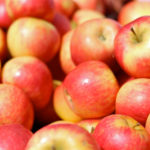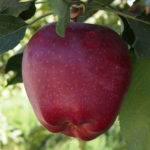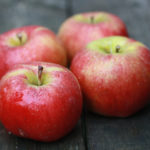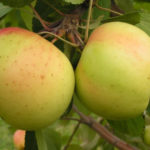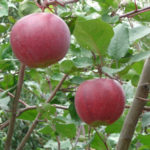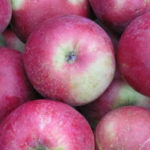Apple variety Granny Smith
This apple tree is one of the most popular varieties in the world with a green fruit color. Even though its history goes back 150 years. The date of the appearance of the long-liver is 1868, the place is Australia. This winter variety is always in the assortment of supermarkets and is available to the buyer. He has good characteristics, and gardeners treat him with special respect. I think many have guessed that this is the Granny Smith apple tree (Granny Smith), or Granny Smith. It was the second reading of the name that was used to enter the culture into the State Register of Breeding Achievements of Russia, which took place in 2006. The applicant and originator was the North Caucasian Federal Scientific Center for Horticulture, Viticulture, Winemaking. In Russia, the North Caucasus region is recognized as the most suitable for growing this variety.
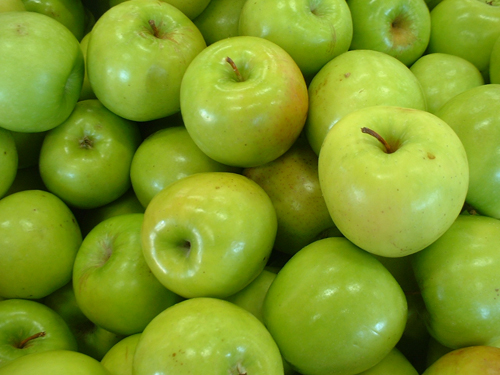
Breeding history
Since the age of our heroine is quite solid, it is unlikely that it will be possible to trace the exact pedigree. However, there are at least 2 origin stories. The first says that the apple tree appeared in Australia. She was brought out by an elderly woman, passionate about selection. Her name was Anna Maria Smith. According to legend, she crossed a wild apple tree brought from France with a local variety. Another version says that as a result of accidental cross-pollination, one single tree has grown with fruits that have high commercial qualities. Subsequently, all attempts to reproduce mutations have failed.
Granny Smith is the first variety that was used for sale in the first chain stores. It was on this variety that the first technologies for selling apples in large shopping malls were tested using advertising, which made the variety recognizable.
Description
The tree is fast-growing, especially in the first 5 years, low - from 2.5 to 3.5 m. The trunk diameter is 15 - 18 cm. The crown is medium thickened, pyramidal in shape. Shoots of medium size, rounded in cross-section, compactly arranged, bare, brownish-brown bark. Lentils are small, light, rounded. The internodes are not long. The leaves are round, obovate, rather large. The apex is smoothly pointed, the base is rounded, the edges are broad-wavy, serrate-serrated. The surface of the leaf blade is matte, green, the reverse side is gray-green. The petiole is normal in length and thickness, uncolored. The flowers are white-pink, about 5 cm in diameter.
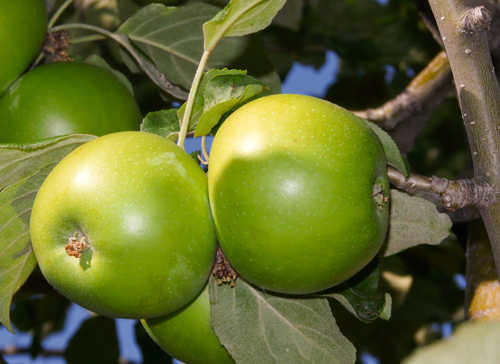
The fruit of the Granny Smith apple tree is well recognizable. They have a regular rounded or truncated-conical shape. The funnel is wide-conical, of medium depth, rustiness may be present. The saucer is not wide, of medium depth. Closed cup. The sub-cup tube is small, wide, and cylindrical. Peduncle of regular length and thickness. The skin is dense, smooth, shiny. The main color is bright green, the integumentary color is absent, only on the illuminated side can a slight tan appear, occupying a very small part of the surface. The subcutaneous points are light, medium or large, well visible, numerous. The flesh is whitish-green, fine-grained, dense, prickly, crispy and very juicy. A cut apple does not darken for a long time in air. The aroma is weak. The taste is excellent, sweet and sour, balanced, refreshing. True, to some it seems sour, but in the process of storage, the sweetness becomes more pronounced. Assessment of tasters 4.4 points. According to gardeners in cool regions, the taste of apples is not good enough, most likely due to the lack of total positive temperatures. The fruits are large. According to the State Register, an apple weighs 148 g, according to other sources - 180 - 200 g, the maximum weight is 300 g. Due to the fact that 100 g of pulp contains no more than 50 kcal, fruits are used in dietary nutrition.
Characteristics
- Many sources call Granny Smith a fairly early-fruiting apple tree that begins bearing fruit 2 to 3 years after planting. According to the State Register, the crop appears only 4 - 5 years after planting;
- the culture blooms in medium terms, so return frosts do not threaten it;
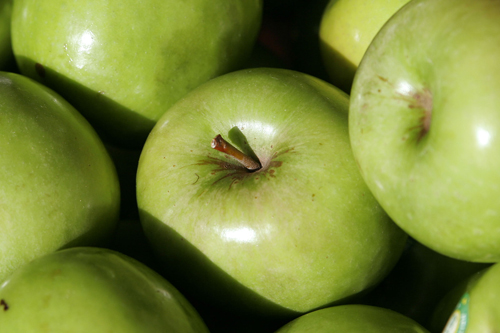
- in terms of ripening, it belongs to the winter varieties. Depending on the region of cultivation, the harvesting period begins in late September - early October. The consumption period begins one month after harvest, to improve the palatability of the apples must mature. But an unripe apple seems completely tasteless;
- productivity is average. The peak yield occurs approximately in the fifth year from the beginning of fruiting, from 15 to 20 kg of fruits are removed from one tree. According to the State Register, 300 centners were collected from one hectare;
- the yield is stable and annual;
- however, the productive period of Granny Smith's life will not last very long - only 10 years;
- a healthy tree is resistant to ripe fruit shedding;
- average winter hardiness. This is confirmed by the tolerance region, which is distinguished by mild winters when the temperature does not exceed minus 13 ° C. Nevertheless, the variety is grown in central Russia, including in the Moscow region, albeit with insulation;
- the tree is moderately resistant to heat. It does not tolerate dry periods, from the heat and lack of moisture, the marketable qualities of fruits deteriorate significantly, the juiciness of the pulp decreases;
- immunity, given the age of the crop, of course, is inferior to many new varieties. But, nevertheless, it cannot be called low. Our heroine is able to resist scab and rust in good years. But resistance to powdery mildew and fire blight is low. There is no data on immunity in the State Register;
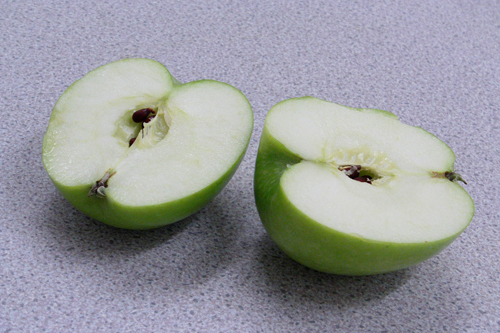
- transportability is excellent. A properly packed crop can withstand long haulage without losing its commercial qualities;
- keeping quality is high. In a cool place, the fruits remain fresh, juicy almost until April, and only improve their taste;
- the main purpose of the crop is to use it in its natural form. In winter, this is especially important, because fruits contain many vitamins and minerals. In addition, apples can be used to make juice, fruit salad, jam, baking stuffing, caramelized apple wedges.
Pollinators
Apple tree Granny Smith is not self-fertile, therefore it needs pollinators that bloom with it at the same time. To increase the yield and improve the quality of apples will help: Pink Lady, Golden Delicious, Ligol, Eliza.
Agrotechnics
Agrotechnics Granny Smith has its own nuances. The best time to plant is warm and humid autumn. The area should be warm and well lit. The apple tree grows rapidly on loose loams and common chernozems, which prevail in the North Caucasus region. In a hot period, watering should not be neglected. The tree needs annual thinning pruning, which reduces the risk of developing fungal diseases. For the same purpose, preventive spraying is carried out in spring and autumn. In cool regions, the stem and skeletal branches are insulated for the winter.
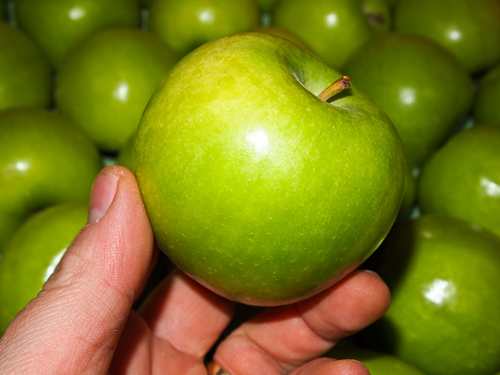
Apple Granny Smith is a well-promoted variety known to most gardeners. The variety has its strengths and weaknesses. Of the advantages, they note the excellent commercial qualities of the fruits, the long storage period, the ability to endure long-term transportation. Also, the advantages are a quick entry into the fruiting period and regular yield. One can argue about the taste, but one thing is certain - in warm regions the taste is much higher. The disadvantages include insufficient winter hardiness and resistance to diseases, the dependence of the quality of the fruits on the presence of moisture and the short productive life of the culture. From the above, we can conclude that the variety is more suitable for growing in regions with a temperate climate.
